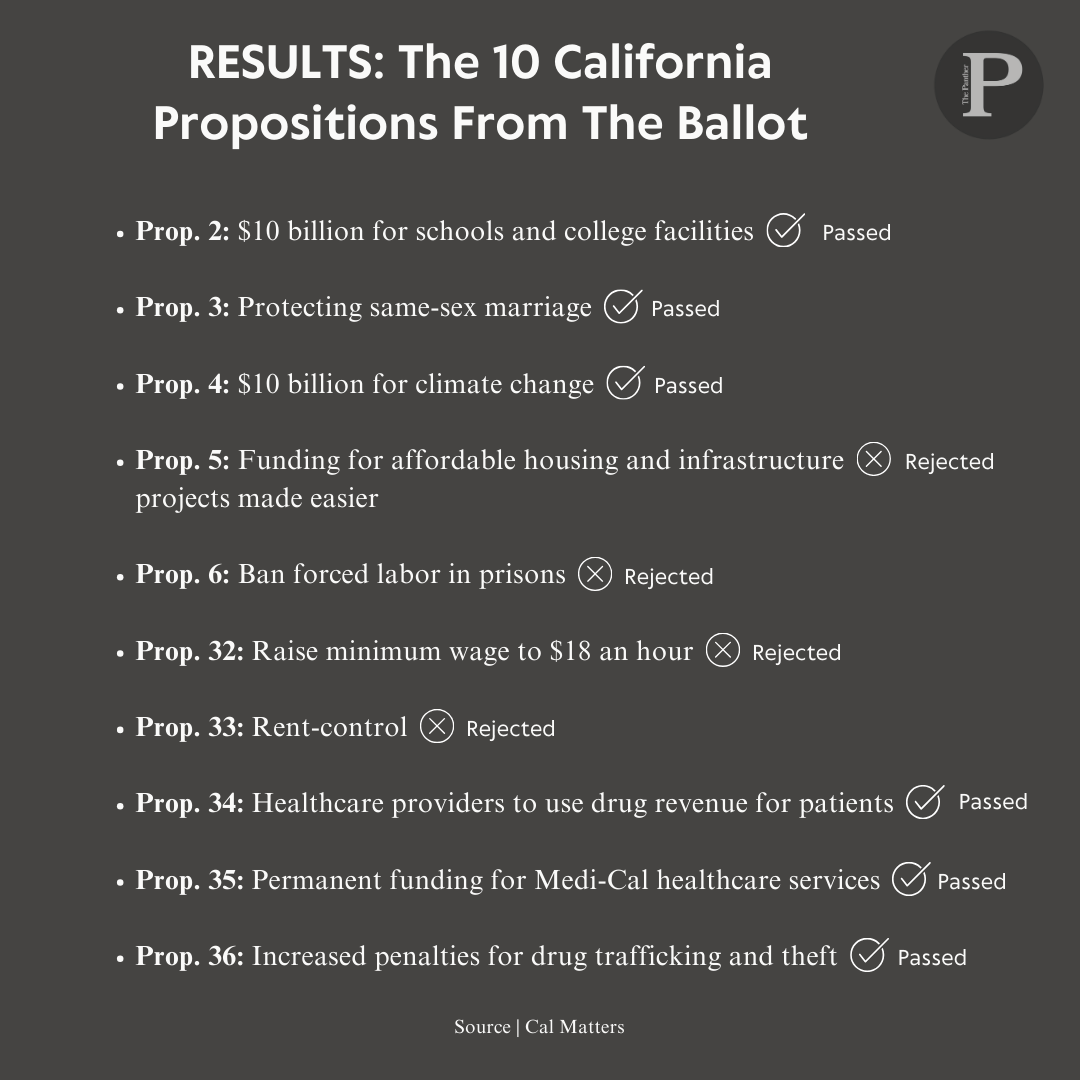Results: The 10 California propositions from the ballot
Graphic by Sukhman Sahota
In addition to the candidates running for office, there were 10 propositions on the ballots statewide in California. Voters decided if they wanted to vote ‘yes’ or ‘no’ on different policies.
In order for propositions to be passed, there must be over 50% of the results to be ‘yes’ and to be denied there must be over 50% of the results to be ‘no.’
Currently, not all of the proposition results have been officially called due to there being 88% of ballots being reported.
Here are the results of the 10 propositions that were on the ballot as of …..
Prop. 2: Authorizing $10 billion in bonds for school facilities - 58.2% passed
This proposition is projected to be passed with 58.2% responding ‘yes’ and 41.8% voting ‘no.’
Prop. 2 being passed will mean that $10 billion worth of bonds will be used to renovate and create facilities for K-12 schools and community colleges.
Prop. 3: Protecting same-sex marriage - 62.5% passed
This proposition is projected to be passed with 62.5% responding ‘yes’ and 37.5% ‘no’.
Prop. 3 being passed will result in amending the California constitution would overturn the ban placed on same-sex marriage and instead state marriage as a fundamental right.
Prop. 4: $10 billion in bonds for wildfire, water and land measures - 59.3% passed
This proposition is projected to be passed with 59.3% voting ‘yes’ and 40.7% with ‘no.’
Prop. 4 being passed will allow for $10 billion in bonds to be put toward water, wildfire and land protection. The majority of the funds will be put towards improving drinking water and protecting against floods and droughts.
Prop. 5: Lowers vote to approve bonds for housing and infrastructure - 55.5% rejected
This proposition is projected to be rejected to be passed with 55.5% voting ‘no’ and 44.5% ‘yes’.
Prop. 5 would have amended the California constitution to lower the vote required to approve bonds for more affordable housing and public infrastructure. The proposed vote was to change the requirement from two-thirds to a 55% majority.
Prop. 6: Ban slavery and forced labor in prisons - 53.5% rejected
This proposition is projected to be rejected to be passed with 53.5% voting ‘no’ and 46.5% voting ‘yes.’
Prop. 6 would have amended the state constitution to not allow slavery in any form, including in the prison systems. This would have repelled the loophole in the 13th Amendment, which allows involuntary servitude as punishment for crime.
Prop. 32: Raise the minimum wage to $18 an hour instead of $17 - 51.1% rejected
This proposition was projected to be rejected to be passed with 51.1% voting ‘no’ and 48.9% ‘yes.’
Prop. 32 would have raised the minimum wage to $18 an hour over $17 beginning in 2025 for employers with more than 25 people.
Prop. 33: Removes ban on local rent control - 60.6% rejected
This proposition is projected to be rejected to be passed with 60.6% voting ‘no’ and 35.9% ‘yes.’
Prop. 33 would have overturned a law from 1995 that banned rent control, which would have allowed local governments to expand the limits for rates of rentals for housing.
Prop. 34: Regulations for spending for some healthcare organizations - 50.8% passed
This proposition is projected to be passed with 50.8% voting ‘yes’ and 49.2% ‘no.’
Prop. 34 being passed will create new regulations on how the AIDS Healthcare Foundation can use money earned from federal discount drug programs in the state.
Prop. 35: Permanent funding for Medi-Cal healthcare insurance- 67.7% passed
This proposition is projected to be passed with 67.7% voting ‘yes’ and 32.4% ‘no.’
Prop. 35 being passed will create an already existing tax permanent for healthcare insurance which gives funding to California’s Medi-Cal program.
Prop. 36: Increased penalties for drug trafficking and theft - 68.8% passed
This proposition is projected to be passed with 68.8% voting ‘yes’ and 31.2% voting ‘no.’
Prop. 36 will increase punishment and penalties for those with multiple theft and drug offenses. The proposition will also create a drug court treatment program for those with repeated drug possession convictions.

